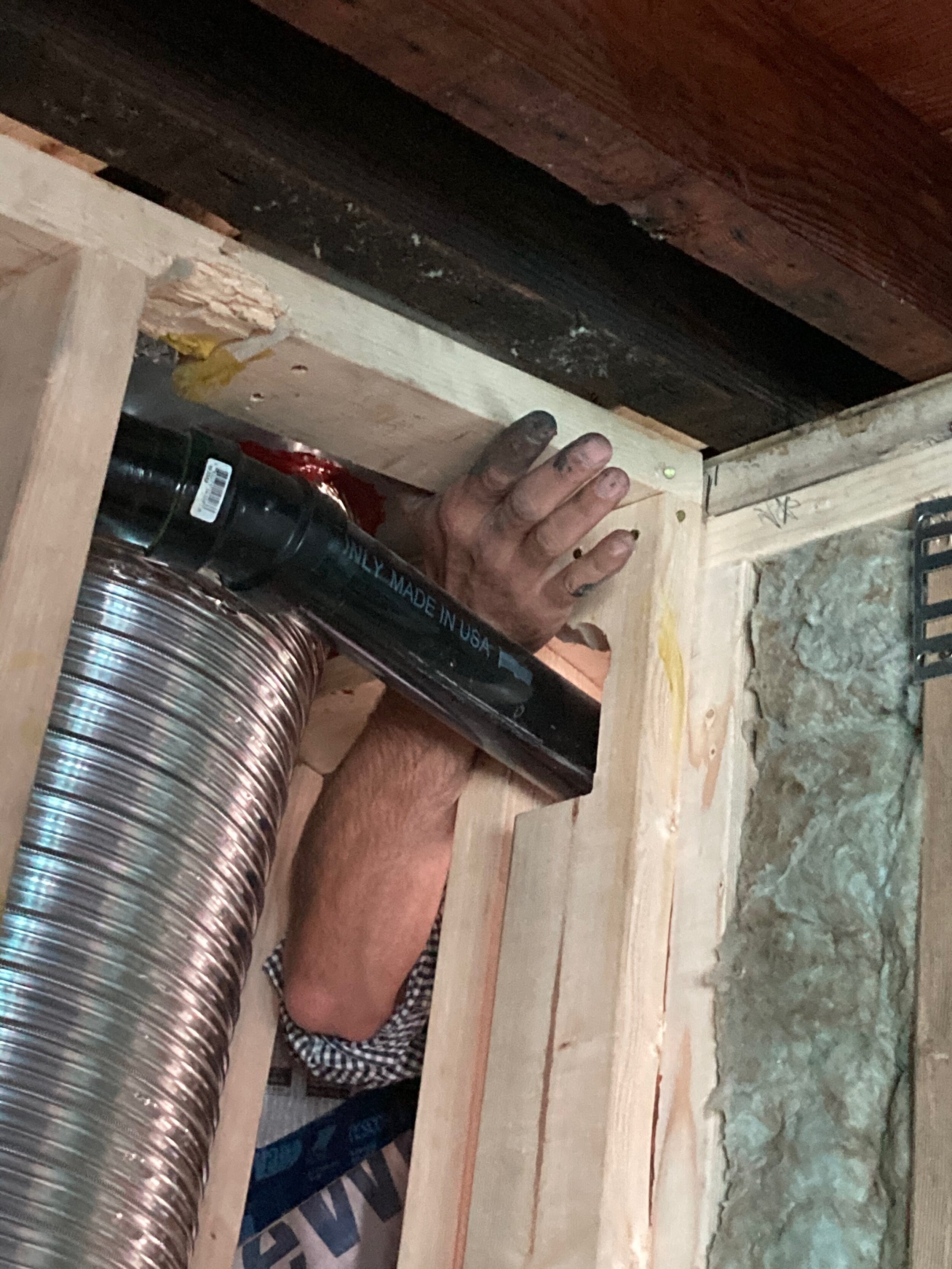The Frontera crew have been preparing for this day for months. The blower door test would show just how successful their efforts to super-insulate the house have been. In the photo below, The front door is open. In its place is the “retro tec” door - equipped with fan which in the first instance will suck the air out of the house. A computer records the conditions inside. There will be some drama once we open that door.
Mark Bernhardt, energy expert, uses his leak-seeking smoker to spot where the air gets in. The pink smoke (a glucose solution) swirls around an air current - giving evidence of air infiltration/outflow - in other words a place to be patched. In today’s first round of testing 4.45 air exchanges per hour were recorded. This is a solid start. Even without improvement, the systems (heat pump and heat recovery) will perform as needed. We are hoping to get to 3 air exchanges per hour. Let the search for leaks begin.
Mark buys glucose solution at a party supply store. This is the same stuff bands use to create smoky effects on stage. Where’s my disco ball?
Upstairs - to our horror, we discover that a section of the batt insulation has fallen out of place and the ceiling is coming down. In effect, in the process of extracting the air the powerful fan sucked insulation down. Taylor and Shaun gamely climbed a scaffold to repair the damage. The operation only took about 20 minutes of rapid action stapling- Now there are staples about every three inches tack the Intello vapor barrier to studs and thus hold the insulation ultra tight. This is a perfect lesson in why you do the blower test BEFORE you ask the drywall team to swing into action.
Oh good! No swirls. The windows are performing as they should. There are lots of hands in closeup in my snapshots today. This wasn’t on purpose —- but on some level I must have been appreciating the handiwork that went into so meticulously insulating the place. To get a new house build’s air exchange per hour under 5 is creditable. To beat that score on an old house is downright impressive. Not only is the house very air tight, it is extremely quiet. Fernwood is a busy road - but we barely hear traffic. Of an August evening pre-renovation upstairs was hot and stuffy.. No more. As a result of the Herculean effort the Frontera team has achieved a 79% reduction in leakiness. How do we calculate this this dramatic turn of events?
% REDUCTION = CFM50 (before) - CFM50 (after) DIVIDED by CFM50 (before) X 100 / 14.50 - 3.01 = 11.49 divided by 14.50 X 100 - 79%
What is ACH 50?
ACH50 tells us how many times per hour the entire volume of air in the building is replaced when the building envelope is subjected to a 50 Pascal pressure… as if the entire building is subjected to a 20 mile per hour wind on all sides. Where does the term Pascal come from you ask?
“YES, THAT BLAISE PASCAL! The pascal (symbol: Pa) is the SI derived unit of pressure used to quantify internal pressure, stress, Young’s modulus and ultimate tensile strength. The unit, named after Blaise Pascal, is defined as one newton per square metre.[1] The unit of measurement called standard atmosphere (atm) is defined as 101325 Pa.[2]
Common multiple units of the pascal are the hectopascal (1 hPa = 100 Pa), which is equal to one millibar, and the kilopascal (1 kPa = 1000 Pa), which is equal to one centibar. Meteorological forecasts typically report atmospheric pressure in hectopascals per the recommendation of the World Meteorological Organization. Forecasts in the United States typically use millibars,[3][4] in Canada these reports are given in kilopascals.[5]”
Aha, another leak has been detected. This time it is close to the stove pipe exiting between the upstairs hall and bath. No sooner spotted than patched by Taylor.
No stone is left unturned. The detectives move to the basement where a spider’s web wafts in the breeze. Charlotte has built a web where rock meets concrete. The crevice is brushed out and filled by Gavyn while Shaun throws some light on the subject. We are now about ready to perform blower test number 2.
The team seen here Gavyn, Matt and Auggie_. awaits results. In round 2 the Air Exchanges per Hour drops to a puny 3.01 - which means that once the dry wall goes up we’ll like get to 2.5. Fantastic work team Frontera! -
Word to the Wise - Always perform a blower test before you buy a house. The tighter the house, the less energy you’ll need to use to keep it warm or cool.
ACH50 tells us how many times per hour the entire volume of air in the building is replaced when the building envelope is subjected to a 50 Pascal pressure. AND…. from Energyconservatory.com
The airtightness of existing homes can vary dramatically based on the construction style, age and region. The chart below shows the relative tightness of homes based on the ACH50.
0 - 1.5 ACH VERY TIGHT
1.5 - 3 ACH TIGHT
3 - 5 ACH MODERATELY TIGHT
5 - 7 ACH LOOSE
7 - 10 ACH VERY LOOSE
10 + ACH EXTREMELY LOOSE
Refer to the International Energy Conservation Code (IECC) tor climate zone specific maximum allowable ACH50 values.






